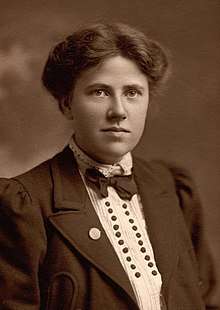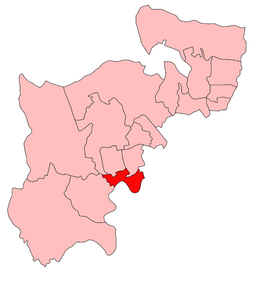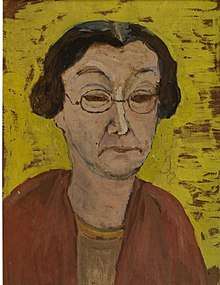Ray Strachey
| Ray Strachey | |
|---|---|
 | |
| Born |
4 June 1887 London |
| Died | 16 July 1940 |
| Nationality | United Kingdom |
| Education | Newnham College |
| Parent(s) | Benjamin Conn "Frank" Costelloe |
Ray Strachey, born Rachel Pearsall Conn Costelloe (4 June 1887 London – 16 July 1940), was a British feminist politician, artist and writer.[1]
Early life
Her father was Irish barrister Benjamin "Frank" Conn Costelloe, and her mother was art historian Mary Berenson. She was the elder of the two girls in her family. Her younger sister was Karin Stephen, née Costelloe, who married Adrian Stephen, Virginia Woolf's younger brother, in 1914. Ray was educated at Kensington high school and at Newnham College, Cambridge, where she achieved third class in part one of the mathematical tripos (1908).
Career
For most of her life, Strachey worked for women's suffrage organisations. Most of her publications are non-fiction and deal with suffrage issues. She is most often remembered for her book The Cause (1928). Papers of Rachel Pearsall Conn Strachey (also known as Ray Strachey, née Costelloe) (1887–1940) are held at The Women's Library at London Metropolitan University. She worked closely with Millicent Fawcett, sharing her Liberal feminist values and opposing any attempt to integrate the suffrage movement with the Labour Party. In 1915 she became parliamentary secretary of the NUWSS, serving in this role until 1920.[2] After the Great War when women were granted the vote and permitted to stand for parliament, she stood as an Independent parliamentary candidate at Brentford and Chiswick on the General Elections in 1918, 1922 and 1923, without success. She rejected the attempt by Eleanor Rathbone to establish a broad-based feminist programme in the 1920s. In 1931 she became parliamentary secretary to Britain's first woman MP to take her seat, Nancy Astor, Viscountess Astor, and in 1935 Stratchey became the head of the Women's Employment Federation. She also made regular radio broadcasts for the BBC.

| Party | Candidate | Votes | % | ± | |
|---|---|---|---|---|---|
| Coalition Unionist | Walter Grant Peterson Morden | 9,077 | |||
| Labour | William Haywood | 2,620 | |||
| Independent | Rachel Strachey | 1,263 | |||
| Majority | |||||
| Turnout | |||||
| Unionist win | |||||
| Party | Candidate | Votes | % | ± | |
|---|---|---|---|---|---|
| Unionist | Walter Grant Peterson Morden | 10,150 | |||
| Independent | Rachel Strachey | 7,804 | |||
| Majority | |||||
| Turnout | |||||
| Unionist hold | Swing | ||||
| Party | Candidate | Votes | % | ± | |
|---|---|---|---|---|---|
| Unionist | Walter Grant Peterson Morden | 9,648 | |||
| Independent | Rachel Strachey | 4,828 | |||
| Labour | William Haywood | 3,216 | |||
| Majority | |||||
| Turnout | |||||
| Unionist hold | Swing | ||||
Family
She married at Cambridge on 31 May 1911 the civil servant Oliver Strachey, with whom she had two children, Barbara (born 1912, later a writer) and Christopher (born 1916, later a pioneer computer scientist). Oliver Strachey was the elder brother of the biographer Lytton Strachey of the Bloomsbury group; other siblings in the Strachey family included psychoanalyst James Strachey, novelist Dorothy Bussy, educationist Pernel Strachey. Ray's mother-in-law was Jane Maria Strachey, a well-known author and supporter of women's suffrage who co-led the suffragist Mud March of 1907 in London.
Art

Strachey painted her sister-in-law, Pernel Strachey, around the year 1930. Her painting is in the National Portrait Gallery in London.[4]
Death
She died in the Royal Free Hospital in London in her early fifties of heart failure, following an operation to remove a fibroid tumor.
Posthumous recognition
Her name and picture (and those of 58 other women's suffrage supporters) are on the plinth of the statue of Millicent Fawcett in Parliament Square, London, unveiled in April 2018.[5][6][7]
Publications
- The World at Eighteen
- Marching On
- Shaken By The Wind
Biographies
- Frances Willard: Her Life and Work (1913)
- A Quaker Grandmother: Hannah Whitall Smith (1914)
- Millicent Garrett Fawcett (1931)
Non-fiction about women's roles
- Women's suffrage and women's service: The history of the London and National Society for Women's Service (1927)
- The Cause: a Short History of Women's Movement in Great Britain
- Careers and Openings for Women
- Our Freedom and Its Results
References
- ↑ Brown, Susan (2008). "Ray Strachey entry". Susan Brown, Patricia Clements, Isobel Grundy (The Orlando Project). Retrieved 12 January 2010.
- ↑ Oxford Dictionary of National Biography
- 1 2 3 British Parliamentary Election Results 1918-1949, FWS Craig
- ↑ "(Joan) Pernel Strachey - National Portrait Gallery". www.npg.org.uk. Retrieved 2018-03-16.
- ↑ "Historic statue of suffragist leader Millicent Fawcett unveiled in Parliament Square". Gov.uk. 24 April 2018. Retrieved 24 April 2018.
- ↑ Topping, Alexandra (24 April 2018). "First statue of a woman in Parliament Square unveiled". The Guardian. Retrieved 24 April 2018.
- ↑ "Millicent Fawcett statue unveiling: the women and men whose names will be on the plinth". iNews. Retrieved 2018-04-25.
External links
- Works by Ray Strachey at Faded Page (Canada)
- Ray Strachey, The Women's Library at London Metropolitan University
- Oxford Dictionary of National Biography
`